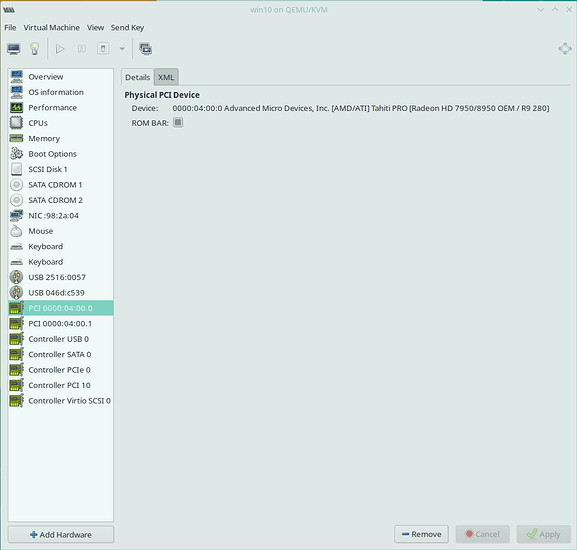Hey there
I thought I’d try this whole VFIO thing with an older GPU to see if it works. Ideally I’d get a low power GPU to run my linux desktop and use my 1660Ti for VFIO but I need to see this working before I can justify buying yet another GPU.
So, I’m gonna post my specs here
Distro: Manjaro
CPU: i5-6500 OCd
GPU (host): 1660Ti
GPU (vm): HD7950
RAM: 16GB 2666MHz
Mobo: MSI Z170a PC MATE
I have set up all the preliminary stuff, Intel VT-d in bios, kernel parameters etc.
shopt -s nullglob
for g in /sys/kernel/iommu_groups/*; do
echo "IOMMU Group ${g##*/}:"
for d in $g/devices/*; do
echo -e "\t$(lspci -nns ${d##*/})"
done;
done;
results in:
IOMMU Group 14:
04:00.0 VGA compatible controller [0300]: Advanced Micro Devices, Inc. [AMD/ATI] Tahiti PRO [Radeon HD 7950/8950 OEM / R9 280] [1002:679a]
04:00.1 Audio device [0403]: Advanced Micro Devices, Inc. [AMD/ATI] Tahiti HDMI Audio [Radeon HD 7870 XT / 7950/7970] [1002:aaa0]
/etc/modprobe.d/vfio.conf contains "options vfio-pci ids=1002:679a,1002:aaa0"
/etc/mkinitcpio.conf contains MODULES="vfio vfio_iommu_type1 vfio_pci vfio_virqfd" as well as HOOKS="base udev autodetect modconf block keyboard keymap filesystems"
I regenerated initramfs after adding modifying these files with
mkinitcpio -g /boot/linux-custom.img
/etc/libvirt/qemu.conf includes
nvram = [ “/usr/share/ovmf/x64/OVMF_CODE.fd:/usr/share/ovmf/x64/OVMF_VARS.fd” ]
I also attempted to pass the device IDs as kernel parameters.
dmesg | grep -i vfio results in
> 82120] Kernel command line: BOOT_IMAGE=/boot/vmlinuz-5.3-x86_64 root=UUID=ce71f013-0d5d-4f05-a55e-d7c87f03efed rw intel_idle > .max_cstate=0 intel_iommu=on iommu=pt vfio-pci.ids=1002:679a,1002:aaa0 > [ 155.007526] VFIO - User Level meta-driver version: 0.3 > [ 155.016667] vfio_pci: add [1002:679a[ffffffff:ffffffff]] class 0x000000/00000000 > [ 155.016670] vfio_pci: add [1002:aaa0[ffffffff:ffffffff]] class 0x000000/00000000 > [ 155.574294] vfio-pci 0000:04:00.0: vgaarb: changed VGA decodes: olddecodes=io+mem,decodes=io+mem:owns=none > [ 156.643322] vfio-pci 0000:04:00.0: vfio_ecap_init: hiding ecap 0x19@0x270 > [ 156.643329] vfio-pci 0000:04:00.0: vfio_ecap_init: hiding ecap 0x1b@0x2d0 > [ 208.826445] vfio-pci 0000:04:00.0: vgaarb: changed VGA decodes: olddecodes=io+mem,decodes=io+mem:owns=none > [johan@johan-pc ~]$
however, lspci -nnk
results in
04:00.0 VGA compatible controller [0300]: Advanced Micro Devices, Inc. [AMD/ATI] Tahiti PRO [Radeon HD 7950/8950 OEM / R9 280] [1002:679a]
Subsystem: Gigabyte Technology Co., Ltd Tahiti PRO [Radeon HD 7950/8950 OEM / R9 280] [1458:254c]
Kernel driver in use: radeon
Kernel modules: radeon, amdgpu
04:00.1 Audio device [0403]: Advanced Micro Devices, Inc. [AMD/ATI] Tahiti HDMI Audio [Radeon HD 7870 XT / 7950/7970] [1002:aaa0]
Subsystem: Gigabyte Technology Co., Ltd Tahiti HDMI Audio [Radeon HD 7870 XT / 7950/7970] [1458:aaa0]
Kernel driver in use: snd_hda_intel
Kernel modules: snd_hda_intel
It should be saying Kernel driver in use: vfio-pci for both of them.
I installed windows successfully, then removed the virtual display, and added the AMD PCI devices for video and audio.
when attempting to run the VM no display pops up.
Additionally, I followed the steps in the arch wiki article PCI passthrough via OVMF to pass keyboard / mouse via Evdev since I only have one of each. This however has not worked since after I hit run on the VM the mouse and kb stop working entirely. This might be due to there being no graphical window, but I’m not sure.
Any help or suggestions are welcome, I’m trying to set this up for the first time so go easy on me if I missed anything obvious please.
Thank you
EDIT
I added softdep radeon pre: vfio-pci to my /etc/modprobe.d/vfio.conf which resulted in the VGA compatible controller reporting vfio-pci as the Kernel driver in use.
The audio device still says snd_hda_intel and I’m still not getting a video in my VM


